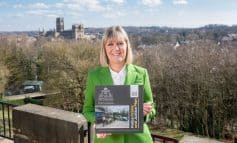A strategy which envisages more than 30,000 jobs and 25,000 new homes has been endorsed by the North-East’s largest council.
Durham County Council has today agreed to adopt the County Durham Plan, through which it seeks to ensure the county is a successful place to live, work, invest and visit by focussing on supporting and creating vibrant communities.
The plans seeks to do this by delivering more and better jobs and sustained economic growth; a wide choice of high quality homes that supports economic growth and meets the needs of all people; a high quality built and enhanced natural environment; and the necessary supporting infrastructure including transport, health and educational needs.
The County Durham Plan includes provision for over 300 hectares of land to be allocated for business and industry development, with the potential for this to create more than 32,000 jobs.
It also envisages almost 25,000 homes being built during the plan period which extends until 2035.
Cllr Carl Marshall, the council’s Cabinet member for economic regeneration, said: “We are delighted that full council has agreed to adopt the County Durham Plan.
“The plan will ensure the county is a successful place to live, work, invest and visit. It will facilitate more and better jobs – more than 32,000 of these, almost 25,000 high quality homes and supporting infrastructure right across the county.
“This will both sustain and support the growth of our economy over the next 15 years in which, like councils across the country, we will be seeking to provide certainty to communities and businesses following the coronavirus pandemic.
“By guiding future development, the County Durham Plan gives that certainty and its adoption is a truly momentous moment.”
The adoption of the plan has been welcomed by prominent business and housing figures in the region.
James Ramsbotham, chief executive of the North East England Chamber of Commerce, said: “County Durham offers so many opportunities for businesses wishing to invest and expand.
“The new County Durham Plan will enable the county council to attract and support new employers with the confidence that housing and other necessary infrastructure will be forthcoming to maximise the potential for all our communities.
“Many will be encouraged by the range of possible developments demonstrating that County Durham has the desire to see progress and really is open for business.”
James Hudson, chair of the Chartered Institute of Housing’s North East board, added: “It is incredibly positive news for the region that Durham County Council has approved the County Durham Plan.
“The research into ensuring the right land is available for the right purposes gives the region confidence that new homes can be delivered and rural communities supported.
“Having a concise plan-led approach which is consistent with national policy will aid the region in our recovery from COVID-19, with the local community, housing need and business economy at its core.”
The plans sets out a range of development proposals as well as planning policies for the county.
This will ensure that the right homes are developed in the right places to meet the needs of residents, including a mix of affordable housing and properties for the elderly on each and every site.
The plan is expected to facilitate thousands of new jobs at locations right across the county, including key economic sites at Seaham, Durham and Newton Aycliffe.
It also looks at ensuring the protection of the historic and natural environment and how infrastructure will come forward to support development, such as new or expanded schools, healthcare provision and community facilities.
The plan includes provision for:
• Housing and employment land – the plan envisages 24,852 new homes across the county and over 300 hectares of new land being allocated specifically for business and industry development, at sites across the county.
• Green Belt deletions at Aykley Heads, Sniperley Park and Sherburn Road.
• Twenty seven housing allocations at sites across the county.
• Affordable housing – the plan proposes that between ten and 25 per cent of homes in all developments are affordable.
• Accessible housing – sixty six per cent of homes will be designed with older people and those with disabilities in mind.
The adoption of the plan follows its examination by a government planning inspector and several rounds of consultation.
The inspector last month concluded he considered the plan sound, subject to a number of modifications.
The adoption of the plan with those modifications was agreed by the authority’s Cabinet earlier this month and was today agreed by full council.








